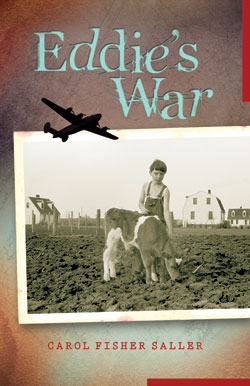Guest post by Carol Fisher Saller
 Writing Eddie’s War, which consists of 76 prose-poem vignettes, wasn’t easy. I’ve chronicled elsewhere the trouble I got myself into by writing the scenes every which-way in random order without first outlining a plot or getting to know my characters. I’d think of a scene and write it—mostly little slices of life. Here’s a short one:
Writing Eddie’s War, which consists of 76 prose-poem vignettes, wasn’t easy. I’ve chronicled elsewhere the trouble I got myself into by writing the scenes every which-way in random order without first outlining a plot or getting to know my characters. I’d think of a scene and write it—mostly little slices of life. Here’s a short one:
May 1939
Sarah Mulberry
In the first grade
she was Sam,
not even all that much
a girl.
Smile as wide as her feet were long,
feet made for puddle-jumping,
fence-hopping,
running from boys.
She could bat a ball and fling a cob
with the rest of us.
In junior high, though,
she became Sarah,
still flashing that smile,
but avoiding the cob fights.
Unless she was
provoked.
Sometimes I’d think of a new character and write a scene for him or her. Sometimes I’d build a scene around something that happened in the 1930s or 1940s, like the crash of the Hindenburg, or the invasion of Poland, or the movie Dr. Jekyll and Mr. Hyde.
This is a terrible way to write a book. But I did have a few characters who kept coming back to me, and two or three story lines that began to emerge. The character of Eddie started speaking in the first person. And I at least had some historical facts in the background that forced a measure of chronology.
And that’s when my group came up with the sentences. (Actually, as I remember it, I was the one who thought it up, and since I’m the one blogging here today, I’m sticking to that.)
The idea is to write a single sentence for each scene or chapter in your book. Include the main plot point and the name of every character who appears in a memorable way:
January 1934, Eddie learns to read newspapers at the library.
May 1937, Eddie and Thomas find some baby foxes and Dad tells them to kill them.
July 1938, Eddie and Gabe argue a moral point.
July 1938, Gabe becomes a hero when Curtis Ray falls out of the tree fort.
September 1938, Dad tells a story about an early experience with a shotgun.
September 1938, Eddie remembers Grampa Rob in the duck blind.
(and so forth)
My list took a couple of pages. Then, in order to see the organization more clearly, I used a different color to highlight each character’s name. (I didn’t color Eddie, since he’s in every scene.)

Standing back a little to look at one color/character at a time, I could see where there were gaps if a character had been away too long. To fix it, I could either move the scenes around or write new ones. And I started marking other things.
- I put a * in front of any scene that included historical or farm-season facts, so I would be mindful of that when rearranging scenes.
- I put an H in front of scenes that had some humor so I could inject some into the dry spells.
My sentences were becoming an outline! Once I had an improved plot summary in front of me, I decided to make use of the character names in another way. From the sentences, it was easy to make a list of all the scenes a character was in. I called these threads:
- Sarah
- Junior High
- In the Ditch
- Typing Contest
- The Date
- The Hat
In the case of Sarah, by studying her thread along with the SENTENCES, and I could see that she was important but underwritten and that her scenes were clumped awkwardly. I saw that there was nothing about her early on, when she was small, and that I needed some scenes of tension between her and Eddie—I couldn’t let love run smooth!
I added plans of scenes to my list of sentences, like “November 1938: Toddler Sarah dazzles toddler Eddie,” and “May 1944: Sarah and Eddie, tense but funny; he tells her about Jozef.” I used square brackets [like this] to indicate scenes that weren’t written yet.
I have to say, it felt great to come to the laptop every morning and have an assignment waiting between those little brackets instead of just a churning feeling that I would never be able to finish the book. Quite honestly, I’ve never been drawn to writing exercises, but approaching my writing problem as one of organization, I surprised myself by finding that organization can lead to inspiration.
I’ll stop here, but if anyone has questions about this technique, I’d be happy to try to answer them. And if anyone would like to know more about Eddie’s War, I hope they’ll visit my website.
http://www.carolsaller.com
Carol Fisher Saller is a senior manuscript editor and assistant managing editor at the University of Chicago Press and editor of the Chicago Manual of Style Online’s Q&A. She has also worked as an editor of children’s books at Cricket Books (Carus Publishing) and has published several books for children. In addition to Eddie’s War, she is the author of The Subversive Copyeditor: Advice from Chicago (or, How to Negotiate Good Relationships with Your Writers, Your Colleagues, and Yourself) (University of Chicago Press, 2009) and currently writes for the Lingua Franca blog at the Chronicle of Higher Education.
Oh, I like this!
I can see it working quite well in Scrivener, too.
About to experiment right now. Thanks for such a clear explanation.